Shatta Sauce (Middle Eastern Hot Sauce)
Shatta is a delicious Middle Eastern hot sauce made from green or red chillies, olive oil and vinegar. Add it to anything in need of a spicy kick! Follow this shatta recipe for a fermented or unfermented spicy sauce.
Like many cookbook fanatics, I first came across shatta sauce in Falastin, the iconic cookbook by Sami Tamimi and Tara Wigley. Tara is known to carry a jar of shatta in her bike pannier wherever she goes. And I understand why!
This delicious Middle Eastern hot sauce is a simple condiment with perfectly balanced acidity – use red or green chillies for red or green shatta.
Fermentation makes this spicy condiment more shelf-stable. It keeps in the fridge for six months – if you can resist the urge to eat it all. But, you can skip the lacto fermentation process if you’re in a rush and opt for a quick-and-easy homemade chilli paste.
I include instructions for fermented and unfermented shatta. However, it’s such an easy and rewarding fermentation project. Why not try it?
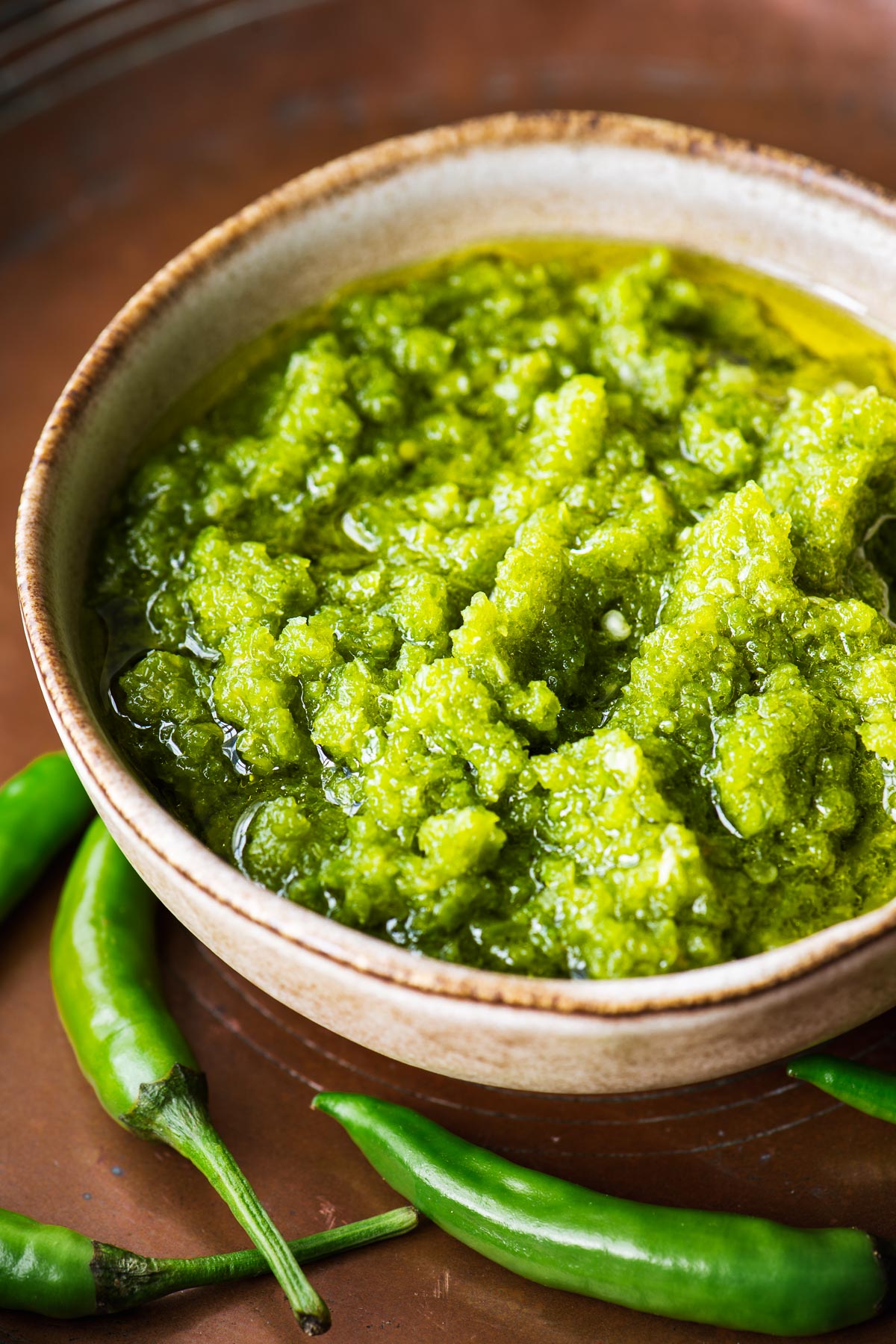
Why I love shatta
- It’s easy: Making shatta at home is one of the easiest fermentation recipes you’ll ever try. This Middle Eastern chilli sauce recipe is perfect for lacto fermentation beginners. Or, skip the fermentation, and make a five-minute Middle Eastern chilli paste!
- It’s versatile: Use it as a condiment for your favourite dishes, marinade for meats or vegetables, or mix it into dressings for a spicy twist.
- It’s safe for dietary restrictions: Shatta is gluten-free and vegan and available for all spicy food lovers to enjoy!
- It’s delicious: Shatta is a staple in Middle Eastern cuisine, and for good reason. It’s utterly delicious.
What is shatta sauce?
Shatta (shattah or shata) is a spicy Middle Eastern condiment, especially popular in Lebanese, Jordanian, Syrian, and Palestinian cooking. It is made from ground chillies and olive oil – with optional vinegar, lemon juice, and spices for flavour. Red shatta can also contain fermented tomatoes.
Traditional shatta is made by pounding chillies with salt and fermenting it in the sun. But, luckily, homemade shatta is made easily with a food processor.
This Levantine hot sauce may be a popular condiment in Lebanese and Palestinian cuisine, but you can use it at home like any other hot sauce. Go ahead and spoon it over salads, dips and sandwiches.
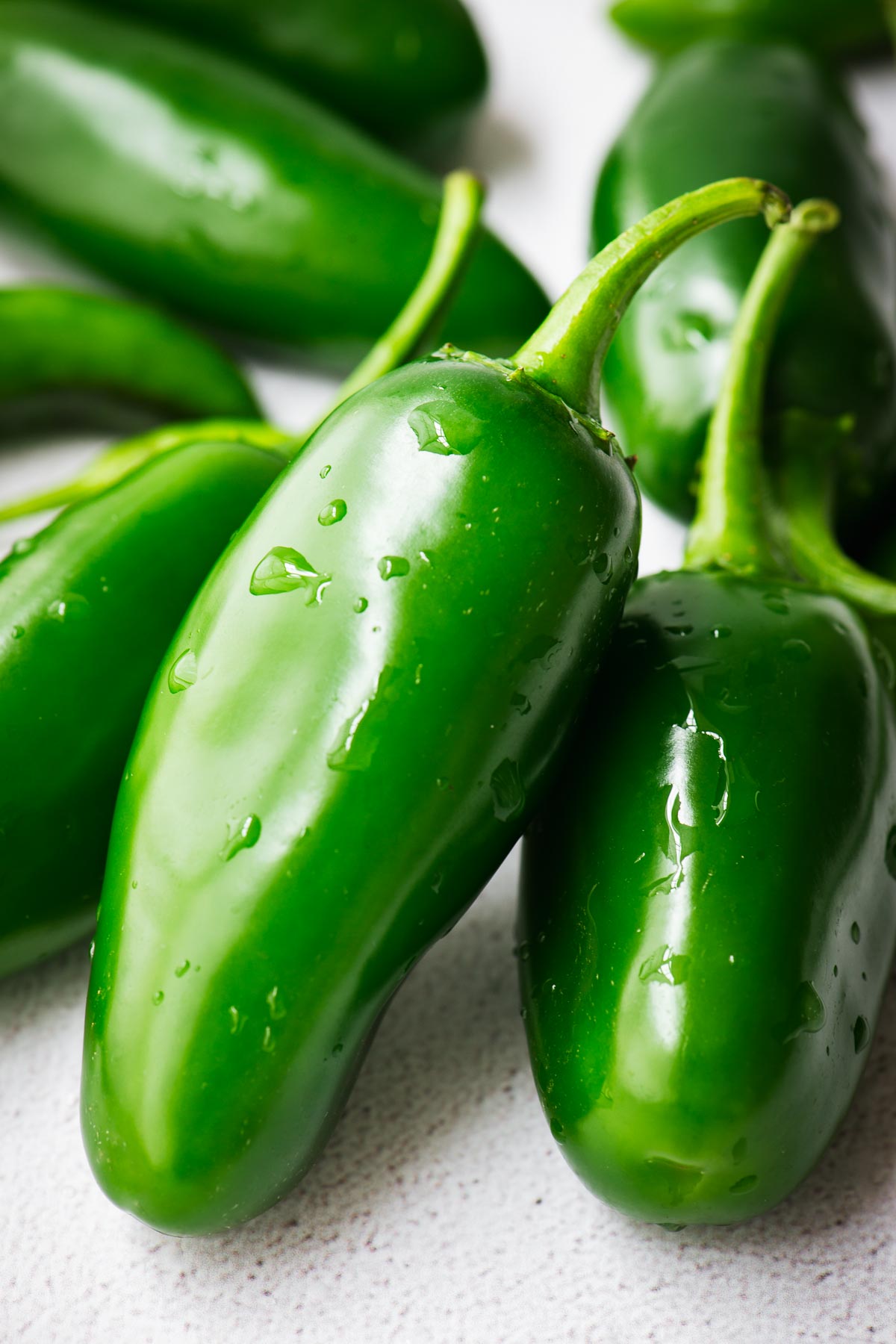
Ingredients
It always amazes me how much flavour you can coax from simple ingredients with the help of fermentation:
- Green or red chillies: You can use any hot peppers that best suit your heat tolerance. Try jalapeños for a less spicy sauce, serrano peppers for something moderately hot, or green finger chillies for a fierce burn. I like to use a mix of the three. Fresh Aleppo peppers are great for a moderately hot red shatta.
- Non-iodised salt: Don’t use table salt for fermentation. Instead, look for salt that is free from anti-caking agents and iodine. These ingredients can inhibit the beneficial bacteria needed for lacto-fermentation. See more about lacto-fermentation below. But you can use table salt if you skip fermentation.
- Apple cider vinegar: I use my favourite organic apple cider vinegar. But you can use white wine vinegar, or any white vinegar.
- Lemon juice: Freshly squeezed lemon juice gives a citrusy acidity to balance the hot sauce, but you can also substitute the lemon juice with more vinegar.
- Extra virgin olive oil: Olive oil gives the spicy condiment its luscious texture. Use the best quality, best-tasting olive oil you have. You will taste the difference.
How to make fermented shatta
Authentic Middle Eastern shatta sauce is one of the easiest fermentation projects you can take on at home. You require no specialised equipment, just a kitchen scale (preferably set to grams) and sterilised jars.
Taking the extra step to ferment the sauce is completely worth it. Not just for the flavour, but also for the extended shelf life.
However, you can skip the fermentation in favour of a quick unfermented shatta sauce.
The process is simple:
- Step 1: Rinse, trim and slice your chillies.
- Step 2: Calculate your salt weight as 5% of the sliced chilli weight.
- Step 3: Allow it to ferment for three days at room temperature.
- Step 4: Drain and blitz into a coarse paste.
- Step 5: Flavour with lemon juice, vinegar and olive oil.
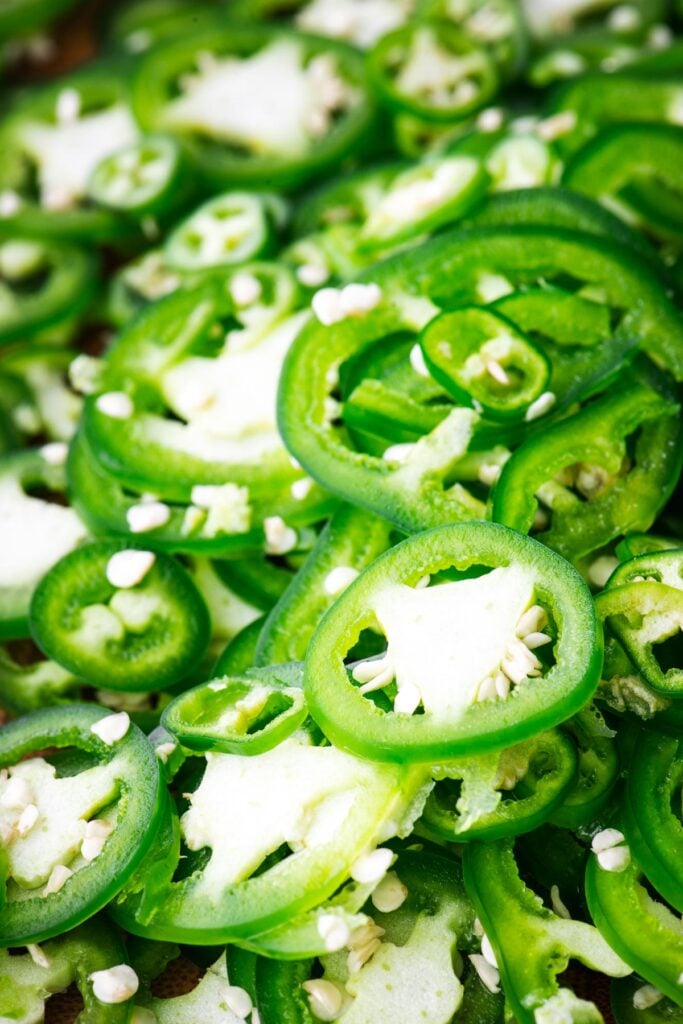
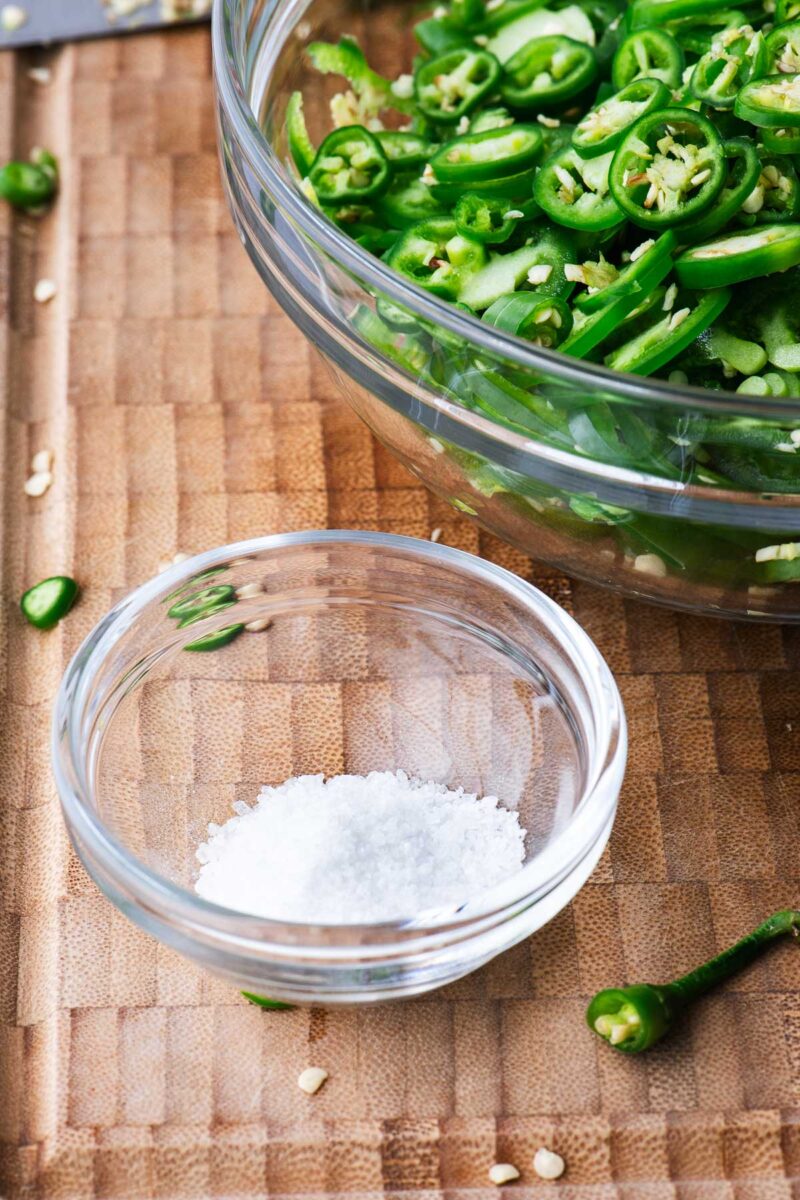
Step 1: Process the chillies. Gently rinse the chillies but don’t scrub them too vigorously. Trim the stems and chop or slice the chillies finely. I like to use a mandolin, but a sharp knife also works well.
Remember to wear gloves when handling chillies – it can leave your hands feeling like they’re on fire for days! And yes, I know this from experience.
Step 2: Calculate the salt weight. Weigh your sliced chillies and calculate five percent of the chilli weight. This is how much salt you will add. For example, if you have 200 grams of sliced chillies, add 10 grams of salt. Mix it well.
When it comes to fermentation, metric weight makes calculations much easier.
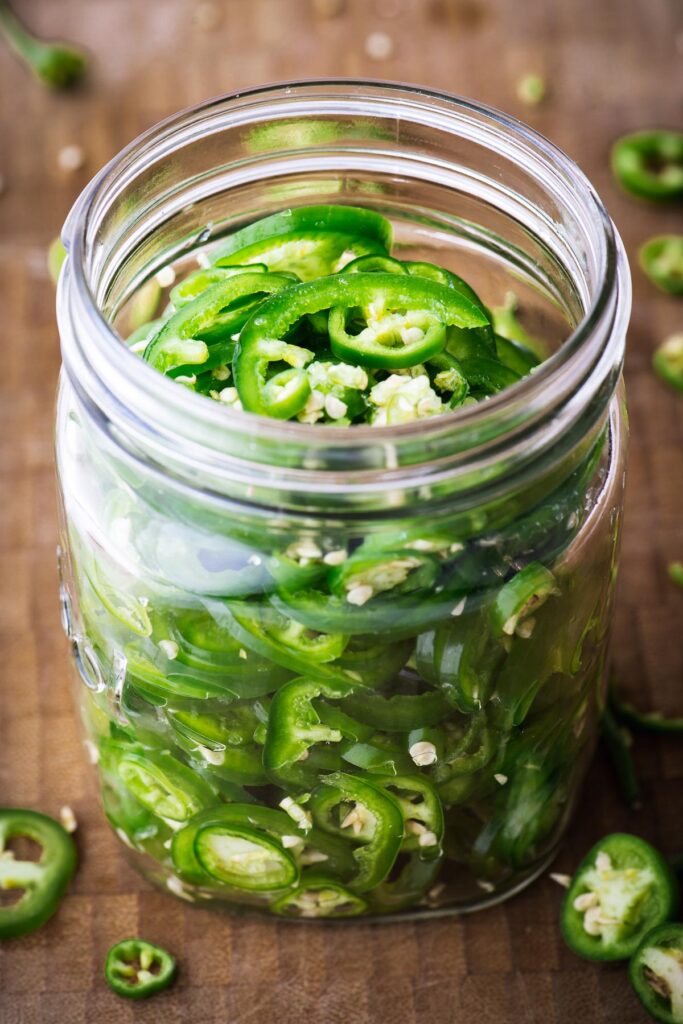
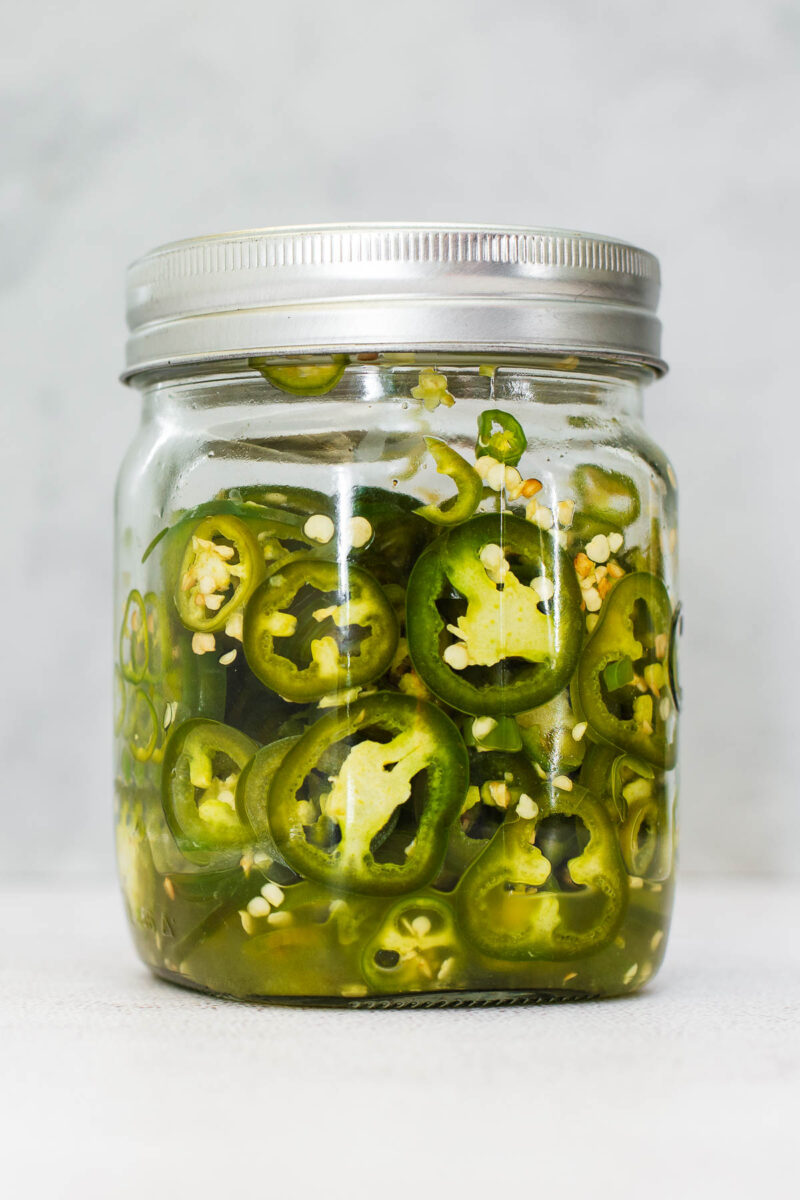
Step 3: Ferment for three days. Add the mixture to a sterilised glass jar, seal it tightly, and keep it away from direct sunlight – a dark cupboard is perfect. Check in daily to give the container a gentle turn to distribute the salty liquid evenly.
After three days, open the lid carefully. It will off-gas slightly with a satisfying hiss and a potent chilli smell. You can extend the fermentation time up to 7 days, but you will need to open the jar to off-gas almost every day to ensure it doesn’t explode.
For me, three days are perfect. But, the rate of fermentation depends on the temperature. My cupboard has a temperature of around 72 °F (22 °C).
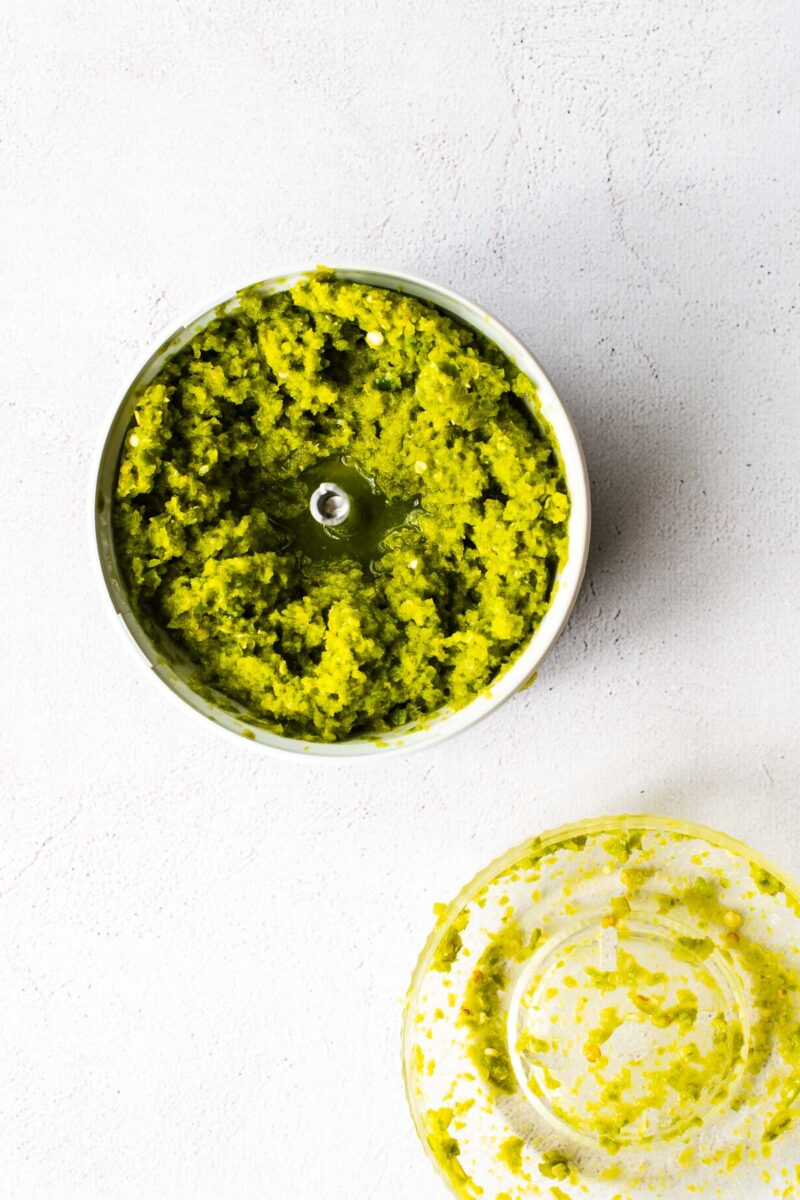
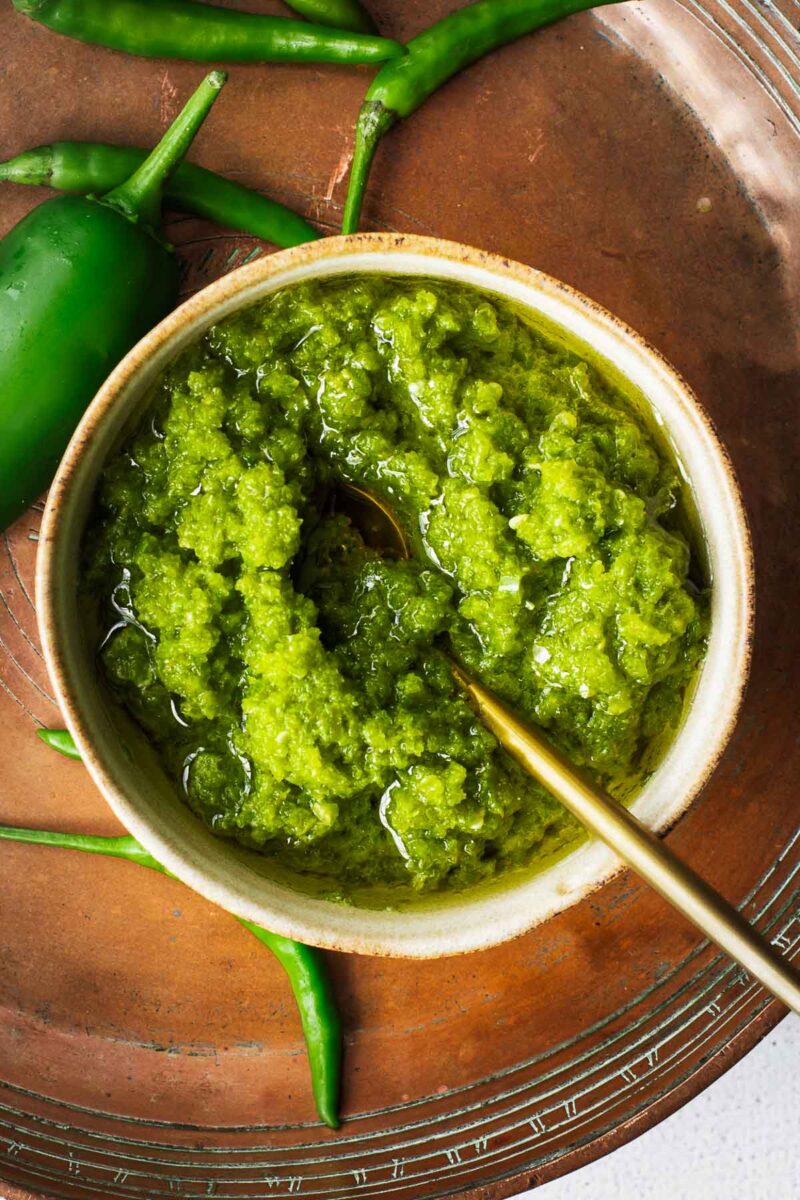
Step 4: Drain and blitz fermented chillies. Drain off the spicy, salty liquid. You can use the liquid in soups and stews that need a spicy kick – like this Moroccan red lentil soup. Place the chillies in a small food processor or spice grinder and blitz according to your preference. I prefer mine a little chunky – which is the traditional way. You can also grind the chillies with a mortar and pestle.
Step 5: Add the vinegar and lemon juice, mix to combine, and put the shatta in a sterilised jar. Top with enough olive oil to cover the top and store it in the fridge for up to 6 months.
During refrigeration, the oil will firm up and settle at the top, so give it a good stir before using.
Fermented vs unfermented shatta
Fermentation is an optional step, but it extends the shelf-life of the condiment and creates an interesting balance in the acidic flavours. The final fermented sauce contains citric acid, lactic acid and acetic acid!
But if you want spicy shatta sauce straight away, you can skip the fermentation and make a fresh, unfermented shatta sauce.
An unfermented shatta will only keep for one week in the fridge (as opposed to six months when fermented).
For unfermented chilli sauce, blitz the chillies with half a teaspoon of salt – you’ll use less salt because you don’t drain it. Stir in the lemon juice, vinegar and olive oil. Then add more vinegar and salt to taste.
Yotam Ottolenghi has a great unfermented red shatta recipe with plum tomatoes.
Lacto-fermentation
When you ferment, you want to create a favourable environment for good bacteria while inhibiting the growth of bad bacteria.
In the case of lacto-fermentation, lactic acid bacteria (LAB) convert sugar into lactic acid. It gives lacto-fermented food its characteristic sourness – think traditional pickles or sauerkraut. Because of this, LAB can tolerate low-pH (acidic) environments. They are also salt-tolerant and anaerobic (they thrive in oxygen-free environments).
5 Tips for successful lacto-fermented chillies
- Don’t scrub your chillies too vigorously. LAB are found on the skins of fruit, vegetables, and humans. Clean your chillies by rinsing them under running water to remove visible dirt. And, avoid chillies that have been coated in wax, treated with pesticides or irradiated.
- Use metric weight. LAB are tolerant of salt, but too much salt can harm them. And, too little salt allows bad bacteria to thrive. Metric weight makes it easy to control salt content more accurately. My shatta recipe calls for five percent salt, but some LAB thrives with up to eight percent or as little as two percent salt.
- Use non-iodised salt without any anti-caking agent like kosher salt. Never use table salt.
- Temperature matters. The bacteria thrive at temperatures between 65 °F and 72 °F (18 °C and 22 °C) but tolerate a much wider range. Cooler temperatures slow down fermentation, and warmer temperatures speed it up. I ferment at roughly 22 °C.
- Always work in a clean environment with clean hands and sanitised equipment.
Lacto-fermentation guidelines in this section are adapted from The Noma Guide to Fermentation by David Zilber and René Redzepi. It is an excellent book if you wish to explore the world of fermentation.
Serving suggestions
Shatta is the perfect spicy pepper paste to serve with any Middle Eastern food – it pairs really well with Lebanese and Palestinian cuisine.
But you can also use it like any other chilli sauce:
- Spread it on sandwiches.
- Spoon it over dips and veggie sides.
- Add it to sauces and dressings.
- Serve it as a side dish for grilled meats.
Or use the chunky Middle Eastern chile paste to replace fresh chopped chillies – it cuts down on chopping and prep time! Try these sauces with a teaspoon of shatta to replace the fresh chilli:
- Coriander salsa: Add shatta to the coriander salsa or simply spoon the shatta over the harissa red lentil soup with a dollop of yoghurt.
- Green tahini sauce: Add shatta to green tahini sauce to use as a dip or salad dressing.
- Mango salsa: Tone down the heat in this mango habanero salsa by swapping the habanero pepper for a teaspoon of shatta.
- Zhoug: Add fresh herbs and spices to create zhoug in an instant!
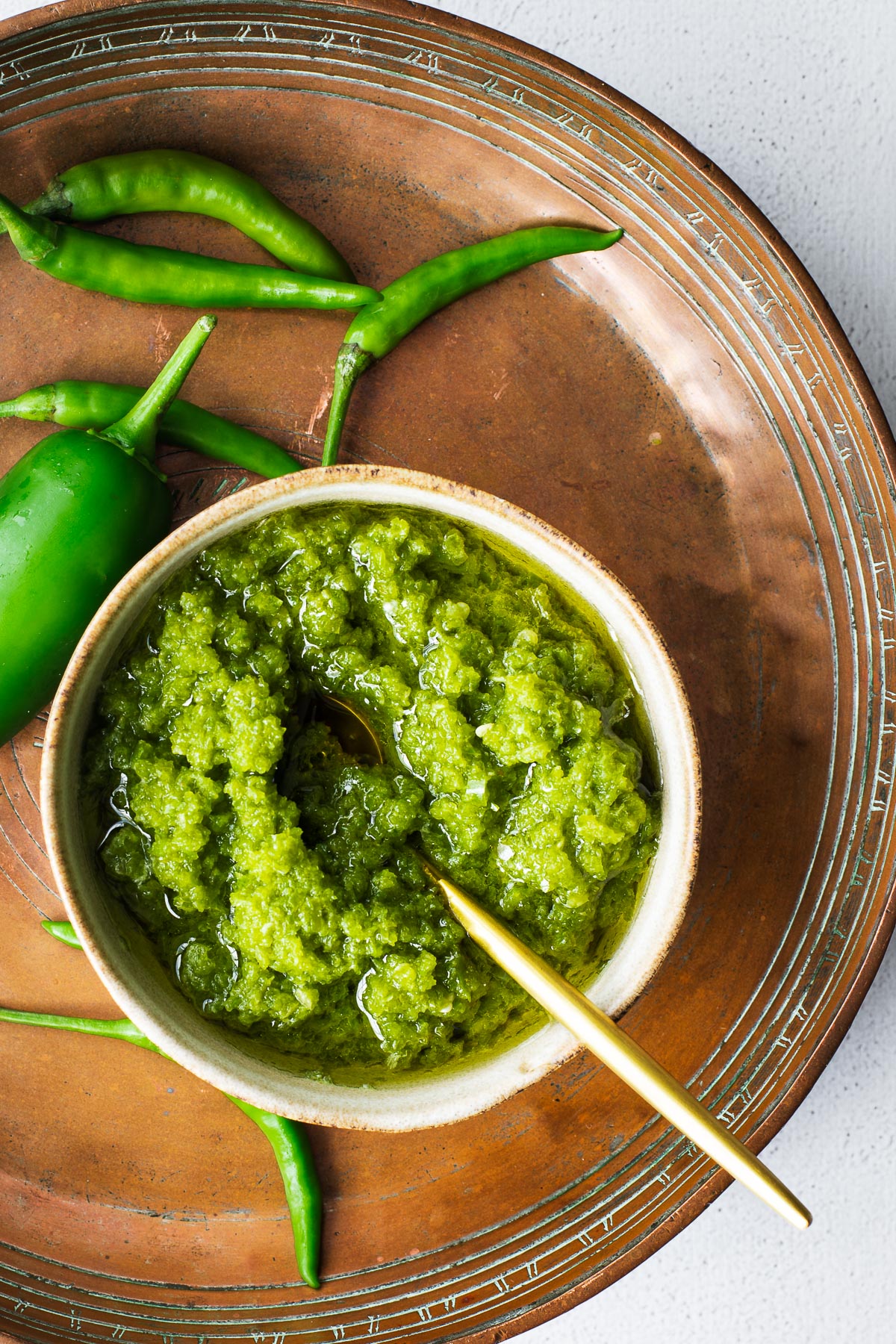
Frequently asked questions
Shatta is a spicy Middle Eastern sauce made from fermented hot chilli peppers, salt and olive oil. Some variations may also include vinegar, lemon juice, garlic cloves and spices like cumin, coriander, and cardamom.
No, shatta and harissa are two different spicy pastes with different ingredients and flavour profiles. While both are commonly used in Middle Eastern and North African cuisines, harissa is traditionally made with dried red chilli peppers, garlic, spices, and (optionally) rose petals for rose harissa paste. And, shatta is made with fermented chilli peppers (green or red), salt, and vinegar. Both pastes are topped with olive oil.
Shata (and shattah) is another name for Shatta sauce, a spicy Middle Eastern sauce made from fermented chilli peppers, salt, vinegar, and olive oil.
Middle Eastern recipes to serve with shatta
- Harissa roasted cauliflower: A buttery, spicy and indulgent vegetarian main that benefits from the refreshing acidity of shatta.
- Barley pilaf with rose harissa: An easy Middle Eastern pilaf to serve with shatta.
- Persian eggplant stew: Slow-roasted eggplant stew with lentils and black lime.
- Arabic salad: A classic Middle Eastern-style chopped salad that loves a spicy kick.
- Kuku sabzi: An easy Persian herb frittata recipe packed with greens and just enough eggs to hold it all together.
- Harissa shakshuka: A wholesome breakfast of eggs poached in a tomato and harissa sauce.
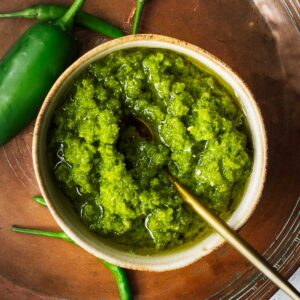
Equipment
- Two-cup glass jar with lid – Sterilised.
- Kitchen scale – Set to grams.
- Mandolin – Or a sharp knife.
Ingredients
- 9 ounces red or green chillies rinsed, trimmed, and roughly chopped
- 2 teaspoons salt, non-iodised with no anti-caking agents
- 1 tablespoon apple cider vinegar
- 1 tablespoon lemon juice
- 2 tablespoons extra virgin olive oil
Instructions
Fermented Shatta Instructions
- Weigh your trimmed and sliced chillies and calculate 5% of your final sliced chilli weight. (If you have 200 grams of sliced chillies, 5% is 10 grams.)
- Add the sliced chillies and 5% salt to a bowl and mix well.
- Place the mix in a sterilised glass jar and seal it tightly. Put the container in a dark cupboard and gently rotate the jar through the upside down position daily to evenly distribute the salty liquid.
- After three days, open the lid carefully. It will off-gas slightly with a satisfying hiss and a potent chilli smell. Drain off the spicy, salty liquid.
- Place the drained chillies in a small food processor or spice grinder and blitz to the desired consistency – I like mine coarse. You can also crush the chillies using a pestle and mortar.
- Stir in the vinegar and lemon juice. Taste the sauce and add more salt if you prefer. It should be very spicy, slightly salty, and pleasingly acidic. Transfer the mix to a sterilised jar.
- Top the chilli sauce with olive oil and store it in the fridge for up to six months.
Unfermented Shatta Instructions
- Place the chopped chillies in a small food processor with ½ teaspoon salt. Blitz into a coarse paste.
- Stir in the vinegar, lemon juice, and olive oil. Taste the sauce and add more vinegar and salt if you prefer. It should be very spicy, slightly salty, and pleasingly acidic.
- Transfer the mix to a sterilised jar and refrigerate for up to one week.
Notes
- If you’re making fermented shatta, don’t wash the chillies vigorously, just rinse off any visible dirt. I also highly recommend using the metric weights (toggle between US Customary and Metric settings at the top of the recipe card). You can be more precise with metric weights.
- If you’re making the quick, unfermented version, feel free to use the US Customary measurements and adjust to taste. Just don’t add all of the salt up front.
- I use a mix of green chillies for green shatta – such as jalapeño, green finger, and serenade peppers – but you can use any one of those. Or use red chilli peppers for red shatta sauce.
- Wear protective gloves if you touch the chilli membranes and seeds with your hands. Or use a mandolin to avoid this.
- During refrigeration, the oil will firm up and settle at the top. Just give it a good stir before using it.

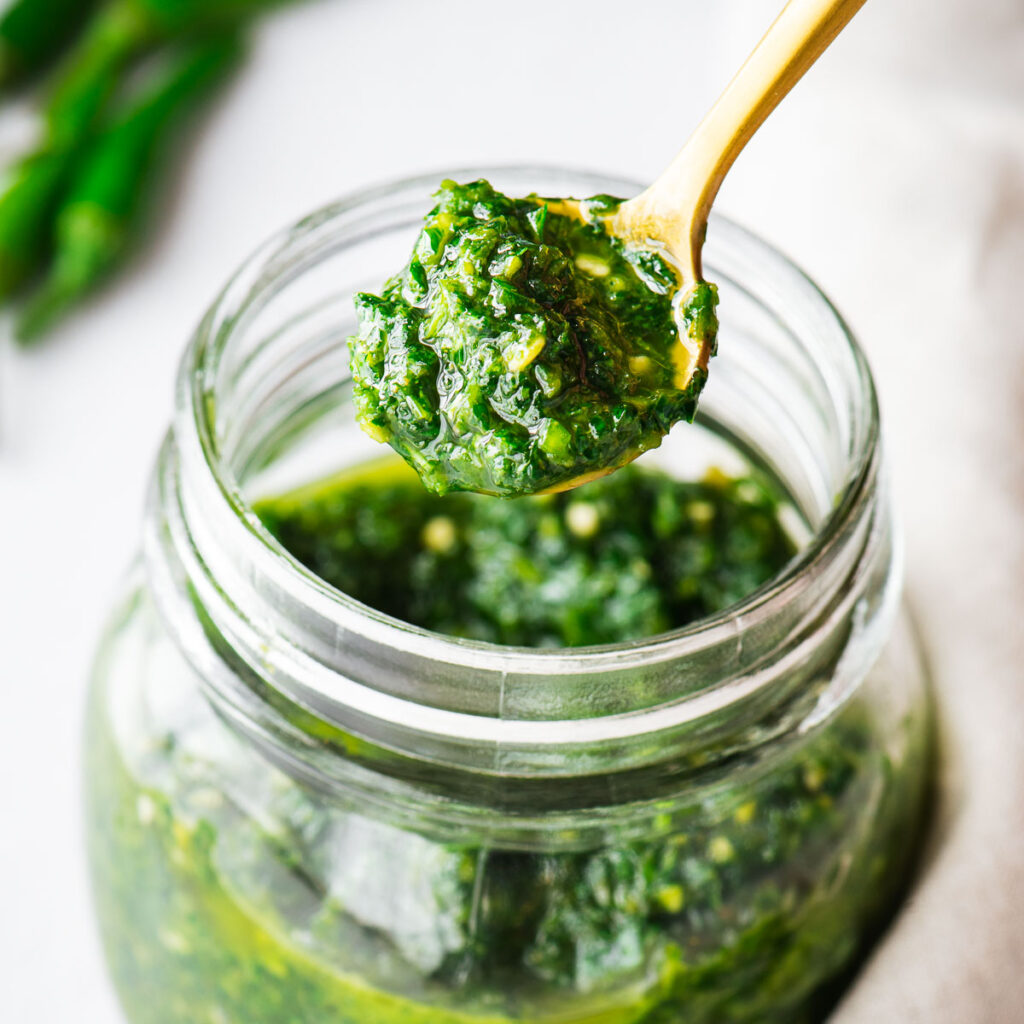
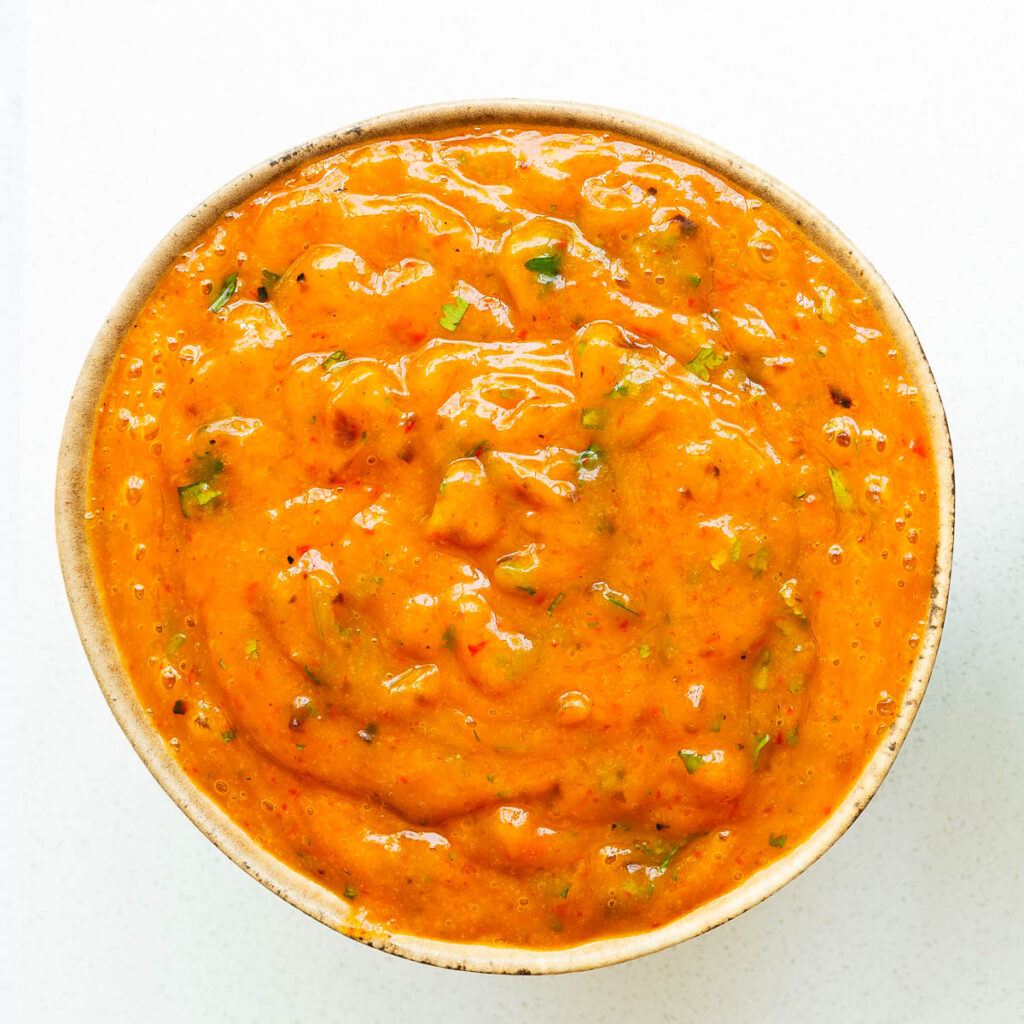
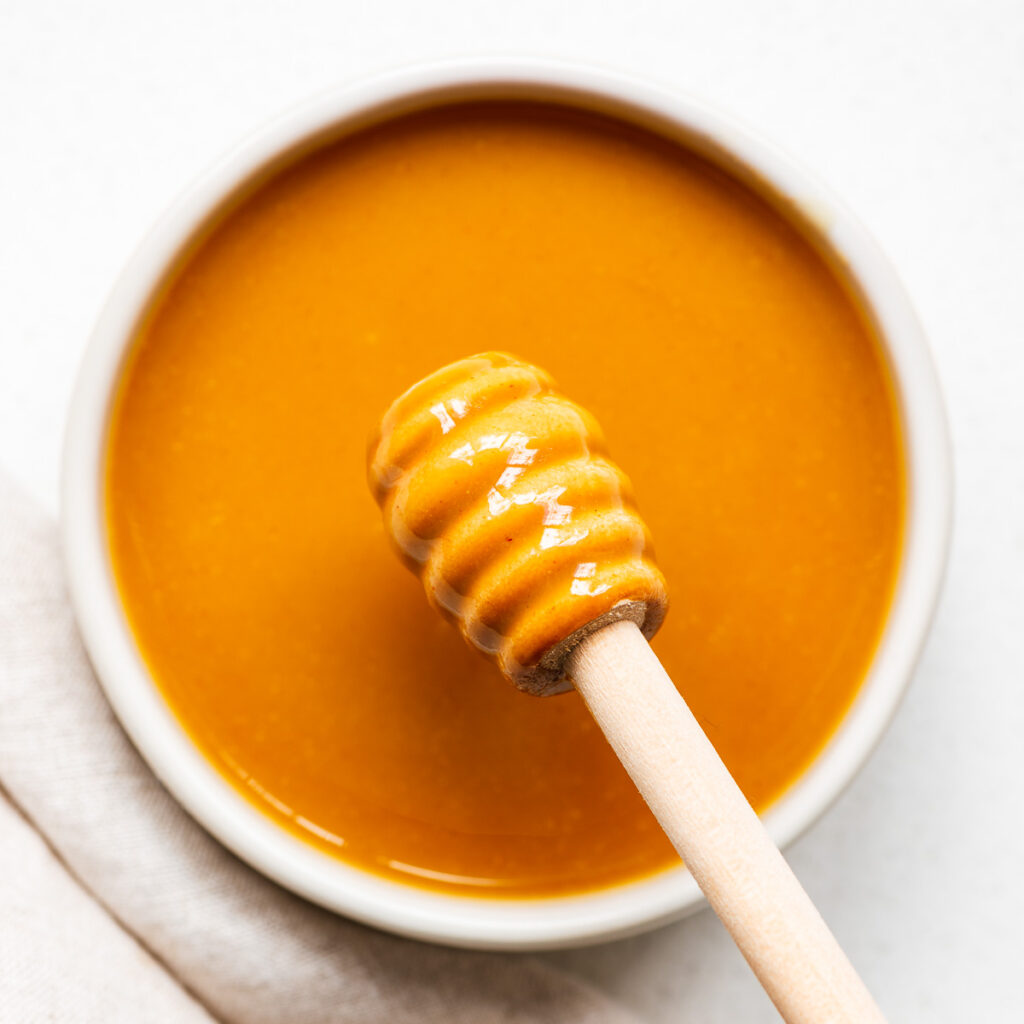
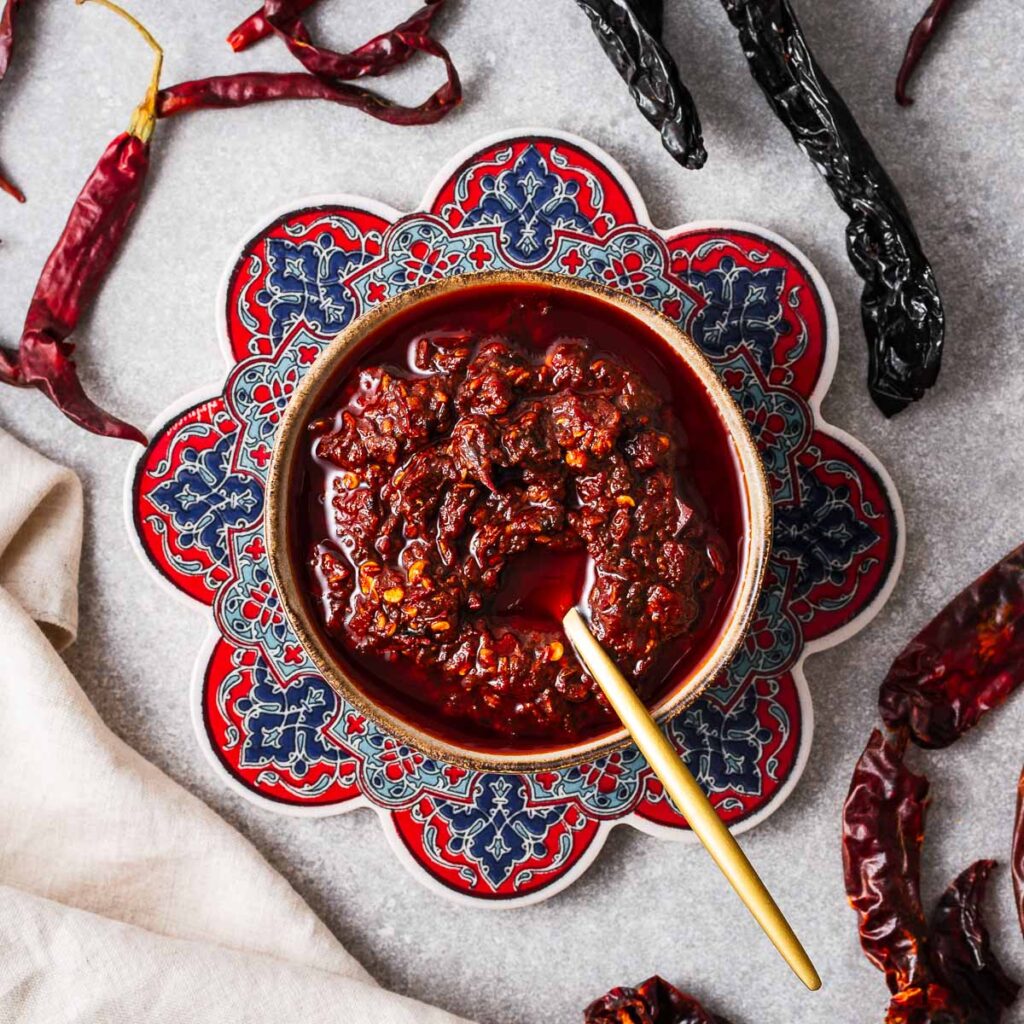
Delicious!
It’s such an amazing spicy sauce! So glad you also love it, Paul. 😊